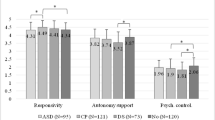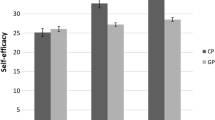Abstract
Psychosocial outcomes have come to the front as a main concern for individuals with Cerebral Palsy (CP), promoting the need to understand the quality of life experienced by children and adolescents diagnosed with CP. As a result, the current study examined the relationships among quality of life in children with CP, the psychological symptoms and parenting characteristics of the parents of these children, and the emotional and behavioral functioning of these children. Results of this study suggested that these variables are related in interesting ways. Further, parenting stress, parents’ depressive symptoms, and children’s internalizing behavior problems were significant predictors of the quality of life experienced by the children in this sample. Thus, the direct benefits from optimizing parents’ mental health as well as that of their children may prove to be an important intervention in helping to improve the quality of life of children who have been diagnosed with CP.
Similar content being viewed by others
References
Abidin, R. R. (1990). Parenting stress index (short form): Test manual. Charlottesville, VA: Pediatric Psychology.
Achenbach, T. M., & Rescorla, L. A. (2000). Manual for the ASEBA preschool forms and profiles. Burlington, VT: University of Vermont Department of Psychiatry.
Achenbach, T. M., & Rescorla, L. A. (2001). Manual for the ASEBA school-age forms and profiles. Burlington, VT: University of Vermont, Research Center for Children, Youth, & Families.
Baumrind, D. (1971). Current patterns of parental authority. Developmental Psychology, 4(1, Pt. 2), 1–103.
Bax, M. (1964). Terminology and classification of cerebral palsy. Developmental Medicine and Child Neurology, 6, 295–307.
Beck, A. T., Steer, R. A., & Brown, G. K. (1996). BDI-II: Manual. San Antonio: The Psychological Corporation.
Bjornson, K. F., & McLaughlin, J. F. (2001). The measurement of health-related quality of life in children with cerebral palsy. European Journal of Neurology, 8(Suppl. 5), 183–193.
Boyd, R. N., & Hays, R. M. (2001). Outcome measurement of effectiveness of botulinum toxin type A in children with cerebral palsy an ICIDH-2 approach. European Journal of Neuorology, 8(Suppl. 5), 10.
Boyle, M. H., & Pickles, A. R. (1997). Influence of maternal depressive symptoms on ratings of childhood behavior. Journal of Abnormal Child Psychology, 25, 399–412.
Britner, P. A., Morog, M. C., Pianta, R. C., & Marvin, R. S. (2003). Stress and coping: A comparison of self-report measures of functioning in families of young children with cerebral palsy or no medical diagnosis. Journal of Child and Family Studies, 12, 335–348.
Buri, J. R. (1991). Parental authority questionnaire. Journal of Personality Assessment, 57, 110–119.
Campis, L. K., Lyman, R. D., & Prentice-Dunn, S. (1986). The parental locus of control scale: Development and validation. Journal of Clinical Child Psychology, 15, 260–267.
Chandler, T. A., Wolf, F. M., Cook, B., & Dugovics, D. A. (1980). Parental correlates of locus of control in fifth graders: An attempt at experimentation in the home. Merrill-Palmer Quarterly, 26, 183–195.
Chilcoat, H. D., & Breslau, N. (1997). Does psychiatric history bias mothers’ reports? An application of a new analytic approach. Journal of American Academy of Child and Adolescent Psychiatry, 36, 971–979.
Eiser, C., & Morse, R. (2001). A review of measures of quality of life for children with chronic illness. Archives of Disease in Children, 84, 205–211.
Evans, P., Johnson, A., & Mutch, L. (1989). A standard form for recording clinical findings in children with a motor deficit of central origin. Developmental Medicine and Child Neurology, 31, 117–129.
Fergusson, D. M., Lynskey, M. T., & Harwood, L. J. (1993). The effect of maternal depression on maternal ratings of child behavior. Journal of Abnormal Child Psychology, 21, 245–269.
Gallagher, J. J., Beckman, P., & Cross, A. H. (1983). Families of handicapped children: Sources of stress and amelioration. Exceptional Children, 50, 10–19.
Gerard, A. B. (1994). Parent–child relationship inventory manual. Los Angeles, CA: Western Psychological Services.
Guyatt, G., Naylor, C. D., Juniper, E. F., Heyland, D. K., Jaeshke, R., & Cook, D. J. (1999). How to use articles about health-related quality of life measurements. In K. F. Bjornson (Ed.), http://www.cche.net/principles/contet_qol.asp.
Hendricks, A. H., De Moor, J. M., Oud, J. H., Franken, W. M., & Savelberg, M. M. (2001). Behavior problems of your motor disabled children at home and in the therapeutic toddler class. European Journal of Special Needs Education, 16, 15–28.
Houlihan, C. M., Hanson, A., Quinlan, N., Puryear, R. D., & Stevenson, M. D. (2003). Intensity, perception, and descriptive characteristics of chronic pain in children with cerebral palsy. Developmental Medicine and Child Neurology, I(1), 29–56.
Houlihan, C. M., O’Donnell, M., Conaway, M., & Stevenson, R. D. (2004). Bodily pain and health-related quality of life in children with cerebral palsy. Developmental Medicine and Child Neurology, 46, 305–310.
Howe, G. W., Feinstein, C., Reiss, D., Molock, S., & Berger, K. (1993). Adolescent adjustment to chronic physical disorders: Comparing neurological and non-neurological conditions. Journal of Child Psychology and Psychiatry, 34, 1153–1171.
Ivan, T. M., & Glazer, J. P. (1994). Quality of life in pediatric psychiatry. Child and Adolescent Psychiatric Clinics of North America, 3, 599–611.
Mackie, P. C., Jessen, E. C., & Jarvis, S. N. (1998). The lifestyle assessment questionnaire: An instrument to measure the impact of disability on the lives of children with cerebral palsy and their families. Child: Care, Health and Development, 24(6), 473–486.
Manuel, J., Naughton, M. J., Balkrishnan, R., Smith, B. P., & Koman, L. A. (2003). Stress and adaptation in mothers of children with cerebral palsy. Journal of Pediatric Psychology, 28, 197–201.
McCubbin, M. A., & Huang, S. T. (1989) Family strengths in the care of handicapped children: Targets for intervention. Family Relations, 38, 436–443.
McDermott, S., Coker, A. L., Mani, S., Krishnaswami, S., Nagle, R. J., Barnett-Queen, L. L., et al. (1996). A population-based analysis of behavior problems in children with cerebral palsy. Journal of Pediatric Psychology, 21, 447–463.
McLinden, S. E. (1990). Mothers’ and fathers’ reports of the effects of a young child with special needs on the family. Special issue: Families. Journal of Early Intervention, 14, 491–504.
Mobarak, R., Khan, N. Z., Munir, S., Zaman, S. S., & McConachie, H. (2000). Predictors of stress in mothers of children with cerebral palsy in Bangladesh. Journal of Pediatric Psychology, 25, 427–433.
Moretti, M. M., Fine, S., Haley, M. A., & Marriage, K. (1985). Childhood and adolescent depression: Child-report versus parent-report information. Journal of the American Academy of Child and Adolescent Psychiatry, 24, 298–302.
Mullen, S. W. (1998) The impact of child disability on marriage, parenting, and attachment: Relationships in families with a child with cerebral palsy. Dissertation Abstracts International: Section B: The Sciences and Engineering, 58(7-B), 3969.
Najman, J. M., Williams, G. M., Nikles, J., Spence, S., Bor, W., O’Callaghan, M., et al. (2000). Mothers’ mental illness and child behavior problems: Cause–effect association or observation bias? Journal of American Academy of Child and Adolescent Psychiatry, 39, 592–602.
O’Donnell, M., Rosenbaum, P., Russell, D., Walter, S., Brehaut, J., & Swinton, M. (2003). Understanding the well-being of caregivers of children with cerebral palsy: Testing a conceptual model. Developmental Medicine and Child Neurology, 46, 31–33.
Ollendick, D. G. (1979). Parental locus of control and the assessment of children’s personality characteristics. Journal of Personality Assessment, 43, 401–405.
Ones, K. (2005). Assessment of the quality of life of mothers of children with cerebral palsy (Primary caregivers). Neurorehabilitation and Neural Repair, 19, 232–237.
Revivo, G. (2000). The use of Tizanidine in a pediatric population: Clinical outcome. Free paper presented at the American Academy of Cerebral Palsy and Developmental Medicine. Toronto, Canada, 21st September, 2000.
Sawyer, M., Antoniou, G., Toogood, I., & Rice, M. (1999). A comparison of parent and adolescent reports describing the health-related quality of life of adolescents treated for cancer. International Journal of Cancer, (Suppl. 12), 39–45.
Schneider, J. W., Gurucharri, L. M., Gutierrez, A. L., & Gaebler-Spira, D. J. (2001). Health-related quality of life and functional outcome measures for children with cerebral palsy. Developmental Medicine and Child Neurology, 43, 601–608.
Spielberger, C. D., Gorsuch, R. L., & Lushene, R. D. (1970). STAI: Manual for the state-trait anxiety inventory. Palo Alto: Consulting Psychologists.
Stanley, F., Blair, E., & Alberman, E. (2000). Cerebral palsies: Epidemiology and causal pathways (Clinics in Developmental Medicine No. 151 ed.). Cambridge, UK: Cambridge University Press.
Tann, B. (1998). Change in ‘Care and Comfort’ follows intrathecal Baclofen. Free paper presented at 2nd Medical Congress of Physical Medicine and Rehabilitation, Valencia, Spain, 23rd May, 1998.
Theunissen, N. C. M, Vogels, T. G. C., Koopman, H. M., Verrips, G. H. W., Zwinderman, S. P., Verloove-Vanhorick, S. P., et al. (1998). The proxy problem: Child report versus parent report in health-related quality of life research. Quality of Life Research, 7, 387–397.
Vitale, M. (2002). Cerebral Palsy: What it is, What can be done. Retrieved March 9, 2006, from http://aolsvc.health.webmd.aol.com/content/article/10/1680_54163?SRC=aolsearch&KW=cerebral_palsy#, January.
Wake, M., Hesketh, K., & Cameron, F. (2000). Functional health status of children with diabetes. Diabetic Medicine, 17, 700–707.
Wallander, J. L., & Varni, J. W. (1992). Adjustment in children with chronic physical disorders: Programmatic research on a disability-stress-coping model. In A. M. La Greca, L. Siegal, J. L. Wallander, & C. E. Walker (Eds.), Stress and coping in child health (pp. 279–298). New York: Guilford.
Wanamaker, C. E., & Glenwick, D. S. (1998). Stress, coping, and perceptions of child behavior in parents of preschoolers with cerebral palsy. Rehabilitation Psychology, 43, 297–312.
Waters, E. B. (2000). Assessing quality of life. In V. A. Moyer (Ed.), Evidence based pediatrics and child health (pp. 79–90). London: British Medical Journal Books.
Acknowledgement
Special thanks to Mark Rapport, Ph.D., and David Ratusnik, Ph.D., for their comments on this project.
Author information
Authors and Affiliations
Corresponding author
Rights and permissions
About this article
Cite this article
Wiley, R., Renk, K. Psychological Correlates of Quality of Life in Children with Cerebral Palsy. J Dev Phys Disabil 19, 427–447 (2007). https://doi.org/10.1007/s10882-007-9041-0
Received:
Accepted:
Published:
Issue Date:
DOI: https://doi.org/10.1007/s10882-007-9041-0




